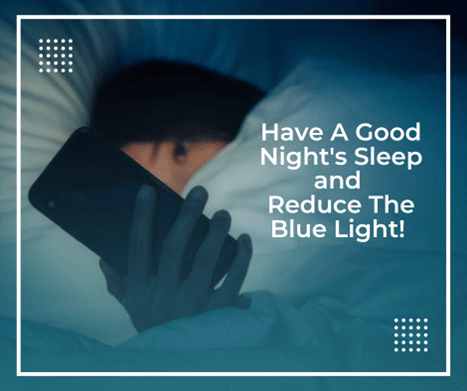Home » Blog » Have a Good Night’s Sleep and Reduce The Blue Light!
Have a Good Night’s Sleep and Reduce The Blue Light!
Posted by: Medical Center Ophthalmology Associates in News

The blue light from your digital devices may affect you from falling asleep and having a quality night’s sleep. You may have experienced trouble falling asleep after staring at your phone or other digital devices right before bedtime. The blue light from your digital devices keeps us up and stimulates us to wake up, whether from the sun or the digital screens we use.
According to a study from Molecular Vision, blue light has been proven to affect the body’s circadian rhythm, our natural sleep, and our wake cycle. Limiting your screen time to one to two hours before bed and using night mode on electronic devices is an excellent habit to adopt for minimizing blue light exposure affecting our ability to fall asleep.
Night Mode Can Help Reduce Blue Light
According to the American Academy of Ophthalmology, dark mode, or night mode, is a setting offered on various digital devices to decrease the screen brightness while reducing eye strain in the process. When using a predominantly white background with black text, the typical dark mode displays a black background with a white or colored text or shifts lighter colors toward pink and red instead of blue. The variations of contrast and colors used in the night mode reduce glare and help our eyes adjust easily to surrounding light, leading to less eye strain and easier, comfortable reading. Decreasing the blue light exposure and limiting screen time and brightness can help you sleep better and feel more comfortable.
Digital Eye Strain Signs and Symptoms
Having trouble falling asleep from viewing your digital devices before bed is one symptom of digital eye strain. Listed below are other signs of digital eye strain that can affect your workday if you are not taking frequent breaks.
- Sore, tired, burning, or itching eyes.
- Watery or dry eyes.
- Blurred or double vision.
- Headache.
- Neck and Shoulder Pain
- Feeling that you cannot keep your eyes open.
Do your best to remember to follow the 20-20-20 rule to minimize the symptoms of digital eye strain. Set your phone timer to remind you to look away every 20 minutes at an object that is about 20 feet away for a full 20 seconds.
How Is Digital Eye Strain Treated?
A simple way to avoid sleep disruption and digital eye strain is to turn on night mode on our iPhone or Android devices. To recharge your body and maintain good eye health, try putting down your digital device one to two hours before bed. If you must catch up on your favorite TV show or read on your digital device during bedtime hours, switch to the night mode settings to eliminate eye strain.
Solutions to digital screen-related eye problems are varied. However, they can usually be alleviated by obtaining regular eye care and changing how you view the digital screen.
If you continue to suffer from digital eye strain or have any discomfort with your eyes, please call us TODAY to schedule an appointment.
We love seeing our patients and helping them see us clearly!

References: American Academy of Ophthalmology, American Academy of Optometry, and the Molecular Vision. This blog provides information and discussion about eye health and related subjects. The content provided in this blog and any linked materials are not intended and should not be considered medical advice. If the reader or any other person has a medical concern, they should consult with an appropriately licensed physician.
